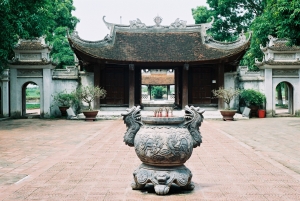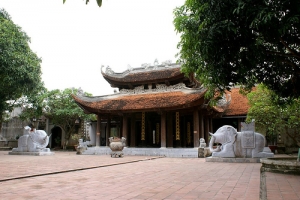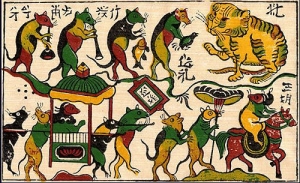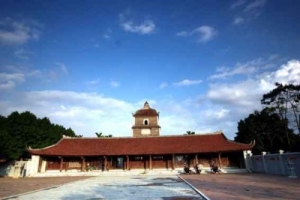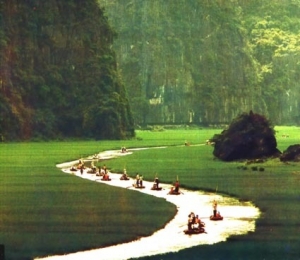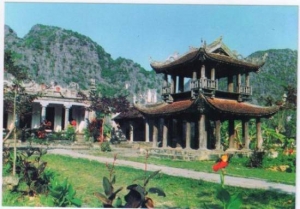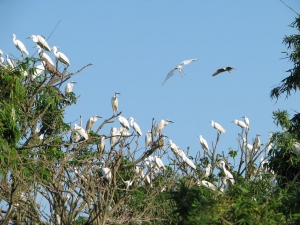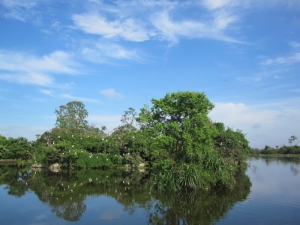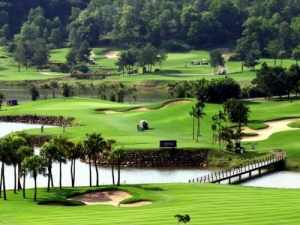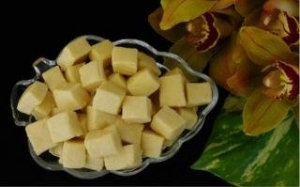
Asia Pacific Travel Team
Do Temple - An ancient temple with unique architecture
Formerly, the Do Temple was famous for its architecture, highly praised through the verses: "The architecture of the Do Temple is marvelous,Worthy to the thousand-year-old history of Thang Long"
Do Temple was built during the Le Dynasty and has been altered several times since. The major reconstruction took place under the reign of Le Trung Hung, in the 17th century.
In front of the Temple lies a semi-circular lake, with clear and full water all the year round. The lake is connected with two ponds at both ends of the village, with the Tieu Tuong River in front of the village. In the center of the lake stands a square house reserved for water puppetry performances with two beautiful tiered roofs. To the south of the lake, there is a huge pavilion to preserve stone slabs inscribed with the merits of the eight kings of Ly Dynasty, and to the north of the lake, a 5-compartment floating house for visitors to take a rest.

The Temple's gate includes five doors made of hard wooden plates assembled together and carved on top images of dragons waiting upon the moon. When the door opens, its two leaves are wide apart, and the two dragons on top of the doors seem to be soaring. On day, the dragons' eyes when catching the light shine like gemstones. Along the three-step staircase, are carved two stone dragons with clouds around, on a green stone floor, symbolizing the Thang Long (Soaring Dragon) Capital.
Passing the gate and a large yard, a green stone paved road leads visitors to a square house, with eight tiered roofs and three compartments, 70m² in area. Then there is a 7-compartment front worship house, 220m² in area, whose front walls are hung with two big posters displaying capital letters: "Eight Kings together brightening" and "Co Phap Commune - a foundation of the Ly Dynasty".
Then a three-compartment house, 80m² in area, with eight tiered roofs. These three compartments are spacious and ventilated and on the axis leading to the Co Phap ancient back pavilion, 180m² in area, and with the floor space in the shape of a Cong letter...

Different parts of the Do Temple are being restored one after another by skilful craftsmen. A rolling of drumbeats was suddenly heard, signaling the start of a procession to bring the tablet of King Ly Thai To from the Do Temple to the Ung Tam Pagoda where the King's mother was worshipped for a reunion of the King and his mother. The procession was attended by a thousand of people, who expressed the spirit of the Vietnamese, i.e. "when drinking the water, think of its source".
If tourists in Vietnam Travel have chance to visit Bac Ninh Province, Do Temple is a must-see place that should not be missed!
Phat Tich Pagoda - a Buddhist cultural center with ancient sculptural
Phat Tich (Buddha’s Trace) Pagoda, located in Phat Tich Commune, Tien Du District, Bac Ninh Province, is a cultural and historical relic in Viet Nam which contains cultural and sculptural values of the Ly Dynasty.
Phat Tich Pagoda, was built between the 7th and 10th centuries, and underwent several transformations throughout the years. It was first renovated during the Ly Dynasty. In 1057, King Ly Thanh Tong had a tower erected and a golden statue made. Later in the 17th century, the pagoda was enlarged. Unfortunately, the pagoda was ravaged by the war in 1947 and was rebuilt again in a simpler style in 1958. And in 1991, the pagoda has been reconstructed following ancient architectural designs.
Among the remains of the pagoda is the Amitabha Buddha stone statue dating back from the 10th-11th centuries, which is considered precious object. The columns of the pagoda are decorated with intricately carved lotus flowers and orchestra with artisans playing various types of traditional musical instruments.

The Amitabha Buddha stone statue dating back from the 10th-11th centuries
According to historical records, Phat Tich Pagoda was as an importance national pagoda, where the Kings of Ly Dynasty often come to hold the Buddhist ceremonies and pray peaceful and prosperous for the country and safety for people. This was not only a Buddhist cultural center but also the place where Buddhist monks were trained. With such special values, Phat Tich deserves as a national vestige where preserves national treasures.
Phat Tich Pagoda was the place where exhibit the largest Buddha Gem statue in Viet Nam – weighing 4.5 tons and standing 3.5 meters high, engraved out of Nephrite stone block, from 16 to 22 of May 2009. The world itinerary of the Buddha Gem statute has been put together to promote world peace. Before arriving at Phat Tich Pagoda, the Buddha Gem statue had visited Da Nang, Vung Tau, Ho Chi Minh City, and Dong Thap in Viet Nam. After leaving Phat Tich Pagoda, the statue traveled to other places in the world such as USA, Taiwan etc. before being settled at the Peace Tower in Bendigo, New South Wales, Australia.
In 2010, the project of renovating and restoring the Historical Cultural Vestige of Phat Tich Pagoda has almost completed which cost 75 billion VND sourced from the State budget and donations from organizations, individuals and Buddhist followers nationwide. The Phat Tich pagoda has named project to celebrate the 1000th anniversary of Thang Long – Hanoi.

The giant Buddha statue has been placed on the Phat Tich Mountain.
Now coming to Phat Tich Pagoda, visitors will have chance to contemplate a new wonder of Bac Ninh Province. That is the statue - 27 metres high (including Buddha's throne and pedestal) and weighs more than 3,000 tonnes which considered as one of the largest stone statues in Southeast Asia and the first of its kind in Viet Nam. It has constructed since February 2007. The statue is shaped based on the model of Amitabha Buddha statue which was made of stone during the Ly Dynasty - a masterpiece of the national fine-art with skillful lines. Therefore, the making of pattern and clothing creases for the giant Buddha statue is a very painstaking work. This giant work is the achievements of tireless labor of many people. Hundreds of artisans from Ninh Van Stone Village (Ninh Binh Province) have worked hard for almost four years under the difficult construction conditions on the mountain. They had to use rail to transport tens-tonnes rocks up to the mountain to preserve the surroundings. The construction of the statue was referenced by many experts. This work was also strictly reviewed and approved.
The giant Buddha statue has been placed on the Phat Tich Mountain at the 108 metres above sea-level with the inner wishes of natural potential as this is place of sacred mountain, Mount of Buddha, marking first place where the Buddhism rose up in Viet Nam.
If tourists in Vietnam Travel have chance to visit Bac Ninh Province, Phat Tich Pagoda is a must-see place that should not be missed!
Dong Ho Folk Painting - aesthetic symbol in Vietnam Culture
Dong Ho Village with its famous paintings has become an aesthetic symbol in Vietnam Culture. Located to the left side of Duong River, Dong Ho stood for centuries making their unique art work. From over 100 families in the 1950s, currently there are only a handful of families still making the traditional craft. Most villagers have now turned to joss paper making, since the regulation has relaxed and again allowed for religious practices that were once deemed “unfit of the revolutionary”. The families of Nguyen Dang Che and Nguyen Huu Sam both run their own galleries and employ a number of workers. To everyone’s relief, the essence still remains and thrives.
Dong Ho paintings are places for artists to reflect their wishes for lucks and their perception of everyday life in the village. Common themes that are found consistently include animals (which has goodluck symbol on them), everyday life (such as Jealous Fight or A Market Day), and folk tales (Saint Giong or The Frog Teacher). The paper used for the painting is made from bark tree so that the texture can retain color for a long time. Each family develops their own mold for the painting. Each mold are then replicated and filled with a separate share of color. The paintings are made by stamping the mold into the paper, one at a time to add more and more color to the picture.

Wrestling - Dong Ho Painting
Dong Ho paintings are simple, meaningful and created for the mass. Patrons use to come from agricultural and low-income families, some of them are illiterate and can not afford other more exquisite art works. But the meaning is the paintings is, by no means, sub-par. It reflects both reality and dream of the people.
Dong Ho these days has also expanded its tradition, and many new products have taken form, among them xyloglyphics and combined-medium works.
A visit to Dong Ho family can take 3-4 hours. For the true art-enthusiasts, skip the amateur Nguyen Dang Che’s tourist-exploiting mill and go sit down and have a talk to the famous but elusive Nguyen Huu Sam or his son Nguyen Huu Qua, who are both masters of their trade.
If tourists in Vietnam Travel have chance to visit Bac Ninh Province, Dong Ho Village is a must-see place that should not be missed!
Dau Pagoda - the Cradle of Vietnam Buddhism
Dau Pagoda, located in Thuan Thanh district, Bac Ninh province, is considered the oldest Buddhist pagoda in Vietnam according to researchers. The pagoda is about 1 hour away from Hanoi Old Quarter, making it easy for a morning trip off the city noise.
History
In the past, the region where Dau Pagoda was built today was the capital of Giao Chi district, the political, economic and cultural center of Vietnam. About 1,800 years ago, the Indian monk named Khau Da La came to this area to do the missionary work and founded the first Buddhism center in Vietnam called Luy Lau. There were many pagodas, citadels and market built in the area at that time and Dau Pagoda was among them.
As Dau Pagoda was the biggest pagoda in the Buddhist center region, many monks from either India or China came there to do research and spread Buddhism to the local residents.
This ancient pagoda has undergone many restorations and expansion, with the largest construction undertaken under the Ly and Tran dynasty. Going through the fluctuation of history, although many structures in the region were destroyed, the pagoda still exists and preserves the traditional oriental architecture style especially the wood block aged about 1752 years old and two bronzes' Xa Loi bodies of Vu Khac Minh and Vu Khac Truong monk.
Architecture
The yard in front of the pagoda hosts a three stories tower name Hoa Phong. The tower originally had six stories but it was partly destroyed. Inside the tower, there are a number of valuable artifacts such as a large bell dating back in Canh Thinh Dynasty (1793), a big bronze gong casted in Ming Mang Dynasty (1817) and several statues of Gods in Buddhist legends.

Visitor Information
Since its inception, Dau Pagoda has hosted the annual Dau Pagoda Festival on April 8th in lunar calendar. This is also the biggest Buddhism festival of the northern region of Vietnam. In 2012, the festival will fall on April 28th.
The oriental architecture style and the antiques at the pagoda will absolutely impress any visitor. Moreover, it is also a great chance for those who want to discover and experience the traditional culture of Vietnam, and a must visit for Buddhists.
The best way to get to Chua Dau is to rent a car with a driver, who already knows the way and will take care of parking issues. You can also ride a motorbike, by following highway 5 and turning to Highway 1B. Chua Dau is about 35km from Hanoi downtown.
If tourists in Vietnam Travel have chance to visit Bac Ninh Province, Dau Pagoda is a must-see place that should not be missed!
Adventure tourists enjoy pushing it to the limit in scenic Ninh Bình
The adventure tour is called the Ninh Bình Challenge. In the Challenge, participating tourists are divided into teams of three and begin their tour through an area known as “Ha Long Bay on land”, an area of rice paddies surrounded by majestic limestone karsts about 90km south of Ha Noi.
The gorgeous countryside and its water buffalo and green and gold rice paddies confirm all the postcard fantasies about Viet Nam.
“This is the first time I have taken part in this kind of adventure tour,” said Pham Thai Minh from HCM City. “The race is fun and the panorama is beautiful.”
“Amazing weekend in Ninh Bình! Biked, ran, climbed, rowed, zip lined instead of abseiled, and didn’t throw up once, haha!,” said tourist Adam Maingot. “Viet Nam truly is a beautiful country.”
Chris Birt, a British geoscientist, said he had heard about Ninh Bình and decided to participate in the tour with a view to seeing everything with his own eyes despite having to fly over 1,700km from HCM City to Haø Noäi and take a two-hour bus ride to the province.
He was really satisfied by the unique tour, he said. Ninh Bình was a great travel destination with imposing and jagged mountains and children cheering as his team passed by. Birt said he would be back next year with his family so they could share the experience with him and visit Bai Dính Pagoda and the surrounding area.
“I was very impressed with the scenery,” said his teammate, American Joshua Turner. “The race was easier than I expected so I was able to enjoy the scenery while running.”
Turner’s team took the top position after two days of events. He cautioned, however, that Ninh Bình was not yet a great place for cyclists due to the truck traffic.
“My previous adventure race was west of Dallas, Texas, and was one long day,” Turner said. “The competition there was much tougher and we came in about 20th out of about 200. Ninh Bình is much prettier though and I’m sure it’ll be much more competitive next year.”
“I wanted to make something different for tourists in Viet Nam,” said Jean-Luc Voisin, director of the Viet Adventure Co, organiser of the Ninh Bình Challenge.
“I hope they can really see Vieät Nam through what’s happening in the villages, not only passing by and looking as tourists often do in normal tours,” Voisin said. “I have worked with the local residents for many years, and I hope that my customers will have chances to admire the beauty of the country through the daily lives of the people.”
He said he modeled the Challenge after adventure tours in southern provinces like Bình Thuan and Dong Nai after he realised that nothing similar was on offer in the north. He chose Ninh Bình after seeing it on a television documentary.
Cliffhanger: Tourists compete in the rock climbing event. — Photo courtesy of Pham Hoang Van
Adventure tours, said Voisin, help people discover their own limits through running, climbing, boating and biking.
“It’s a strong motivation for people to compete with themselves and prove that they can do a lot of different things and overcome challenges,” he said.
Participants in the Ninh Bình Challenge had to train regularly in preparation for their tour, which would require them to mountain bike for 50km before a 14km hike, 20m of rock climbing and 4km of boating.
“I went to a gym one month before the tour to improve my strength and endurance,” said Minh, who nevertheless suffered a cramp during the biking tour.
Birt and Turner said they went cycling every weekend and running four times a week to make sure that they would able to meet the Challenge.
Among around 50 adventurers, Jordan Kindness, a 10-year-old girl, was the youngest racer. But she brought a surprise to all the rivals by successfully passing all the obstacles and, together with her parents, winning the adventure category – even after sinking a traditional boat and having to start this part of the race.
Kindness met no difficulty in finishing the 25km biking and 8.5km running events. And while rock climbing and zip lining tested the strength and skills of the adult participants, for Kindness, it was a piece of cake.
“It’s hard to keep up with her – she has to wait for us,” laughed her parents.
For her performance, Kindness received a special offer to take part in Viet Adventure’s next event, the Madagui Trophy, in the Central Highlands province of Lam Dong in February.
Thai Vy Temple- A unique combination of architectural design
Located to the West of Van Lam Hamlet, Ninh Hai Commune, Hoa Lu District, Ninh Binh Province, Thai Vy Temple was built to worship four generations of Kings Tran, Tran Thai Tong, Tran Thanh Tong, Tran Nhan Tong, and Tran Anh Tong.
According to the history, Thai Vy Temple was built during Tran Dynasty follow the internal attack with outside support (noi cong, ngoai quoc) architecture.
In front of the temple is Ngoc Well by green stone with clear and full water all the year round. Behind the temple is Cam Son Mountains with rank trees.
 Entering into the temple, at triumphal arch (nghi mon) there are two green stone monolithic horses. Passing the nghi mon, 2-storey iron wood bell-tower with eight-roof of mui hai tile is on the right. Corners of the bell-tower roof are very bend like the tail of phoenix. The bell inside was cast in 1689.
Entering into the temple, at triumphal arch (nghi mon) there are two green stone monolithic horses. Passing the nghi mon, 2-storey iron wood bell-tower with eight-roof of mui hai tile is on the right. Corners of the bell-tower roof are very bend like the tail of phoenix. The bell inside was cast in 1689.
Interior temple with spacious worship rooms are decorated very meticulous. Many stone pillars in round or square are carved on with parallel sentences and many shapes such as dragons, phoenixes, unicorn, turtle and the image of cam, ky, thi, hoa (music, chess, poetry, painting - regarded as the four amusements or accomplishments of a feudal intellectual).
In the sanctum, statue of King Tran Thanh Tong (the first-born child of King Tran Thai Tong) is between statues of his parents (King Tran Thai Tong and Queen Thuan Thien). Besides, the votive tablet of King Tran Nhan Tong (the first-born child of King Tran Thanh Tong) and the votive tablet of King Tran Anh Tong (the first-born child of King Tran Nhan Tong) is worship here.

Thai Vy Temple- Hoa Lu- Ninh Binh Province
Every year, Thai Vy Temple Festival takes place on the 14th day of the 3rdlunar month. There are activities such as palanquin procession, sacrifice ceremony, human chess playing, wrestling contest, dragon dancing and boat rowing, etc.
Participating Thai Vy Temple Festival, pilgrims and visitors in Vietnam travel will have a chance to visit scenic spots here, watch the mountains, vast clouds of water, also get the chance to drop in the wind that worries secular to the direction of the source, and to commemorate the merits of King Tran.
Contemplating the beauty of stork island in Hai Duong
The stork village belongs to Chi Lang Nam Ward, Thanh Mien District, and stays 25 kilometres far from Hai Duong City. There is a small island locating in the middle of the lake and its area is around 30 hectares wide. That is the place where thousands of storks are residing. The stork family here is quite various, including a plenty of species: white stork, fiery stork, cattle egret, grey stork, and so on. Thousands of herons and rare and valuable birds can be found here such as pelicans or teals residing together.
According to local people in Chi Lang Nam, there are many interesting legends about the stork island. In the past, this area was sunken and the island was formed in the 15th century after the dyke of the Red River collapsed because of a big flood. Gradually, it became the home of different varieties of storks, herons and birds.
Every year, in September of the lunar calendar when the north-east wind blows, thousands of storks, herons and birds from other places fly to the island. They often stay there until April of the following year. Therefore, the island becomes a destination of tourists and an environmental education centre is there to help raise awareness of environmental protection.
The best time to visit Chi Lang Nam Stork Island is at sunrise or sunset. At these times, visitors will have a chance to behold a beautiful painting with white storks and herons flocking out of and into the lake. Tourists will enjoy a spacious and greenish space with the peaceful landscape of a rural area. It is wonderful to mingle with nature and be away from our busy lives.
Dao Co - beautiful and attrective natural destination in Hai Duong Province
Location: In Chi Lang Nam Commune, Thanh Mien District, Hai Duong Province.
Characteristics: It's home mainly to a mere nine varieties of storks, Chinese pond herons, jabirus, buff-backed and grey herons, and the grey, blue and black bitterns.
To the growing list of places in Vietnam that claims to have discovered eco-tourism, add the name of Dao Co (Stork Island). It will have to take its chances for the claim along with all the others but certainly they won't be lessened by its celebrated Island of Storks.
It nestles in Chi Lang Nam Commune and has been quietly pulling bird-watchers - around 15,000 annually, to an out-of-the way part of Hai Duong Province - since the early 1990. That's a modest figure but local tourist officials are hoping to spread its attractions wider without trampling on the very nature that attracts visitors in the first place. Welcome to eco-tourism - welcome to the problem.

Dao Co, one writer enthused "rises like a jewel blessed by nature" in the middle of the 2,832km2 in Chi Lang Nam. Few ornithologists - those birdwatchers - would disagree. It's home mainly to a mere nine varieties of storks, Chinese pond herons, jabirus, buff-backed and grey herons, and the grey, blue and black bitterns, stopping off on their way to China, Myanmar, India and Nepal. But don't forget the common teal, wild ducks, moor hens, the pelicans or the snipes - all faithfully recorded in the Vietnam's nature bible, the Red Book. But it's this time of year that most excites visitors and locals as spring heralds the arrival of tens of thousands of storks. Local experts somehow seem to have deduced that each flock of storks numbers 70, arriving in clusters as night falls to take up residence on their island.
In 1996, the Vietnam office of the UN Development Programme proposed turning Dao Co into an environmental education centre in a two-year, a project which would see planting of bamboo trees and introducing teaching programmes to raise awareness of environmental protection. There are plans to make Dao Co part of an eco-trail starting from Hanoi, winding through Hien Street to Stork Island and on to Con Son, Kiep Bac and Haiphong, and back to the capital.
If tourists in Vietnam Travel have chance to visit Hai Duong Procinve, Stork island is a must-see place that should not be missed!
Chi Linh Star Golf & Country Club - international standard Club
Location: Sao Do Town, Chi Linh District, Hai Duong Province, 48km from Hanoi along the road going to Halong Bay.
Characteristic:Chi Linh Star Golf & Country Club is an international standard Golf and Country Club which is in the center of the strategic Economic development and Tourism triangle of the North of Vietnam: Hanoi - Haiphong- Halong (Quang Ninh). Chi Linh Star Golf & Country Club is an ideal destination for golfing tourists.
The Chi Linh Star Golf Course features a 36-hole golfing challenge, with every hole constructed and designed to international standard. "The Best Place To Play" begins with nine holes, opened in November 2003.
The 160ha site on which the course is being constructed lies within a beautiful valley, surrounded by rolling forest hills, and nestles beside a large lake complete with rolling creeks and natural water flowing from the surrounding area. 11 holes over 36 have water risks (6 over water and 5 touching water). The hotel of golf club features 90 deluxe rooms and suites, two restaurants, conference facilities, resort spa services, tennis court, swimming pool and spa, 24 hour room service, nightclub and two bars.
A visit to Chi Linh will no doubt leave a lasting impression, whether it be for a great round of golf, or simply having made the visit to a truly special place, transformed with care and attention to every detail.
If tourists in Vietnam Travel have chance to visit Hai Duong province, you should go to Chi Linh Star Golf & Country Club to try playing in here!
Hai Duong - a beautiful landscape together with hiden charming and cultural value
Hai Duong is a well – off land with charming nature – landscapes and beautiful sites such as Con Son and Kiep Bac temple where is known by many people. Con Son called Hun Mountain, high nearly up to 200 meter and 1 kilometer in length. Con Son peak has more than 900 levels of stone arranged meanderingly across and pine – hill whispered soft and show and windy. On top was remaining a vestige of an ancient architecture with the shape of Cong located in an even and flat area. Tree hill rolls four sides, to head foreards northeastern in the distance, elbow across the verdant valleys and quiet and gentle villages, you will be in Kiep Bac – a famous historical monument. It’s a place where conserves plenty of highly valuable things and the sensational legends of the national hero Tran Quoc Tuan.
Specialists were well – known for along time in domestic that’s Hai Duong’s china and pottery and cakes made of ground green lentils. Those products have brought the national culture and tradition. Although those were small and simple but have spread over the world and reflected great sourec of revenue for Hai Duong native land. The raw materials use to process those cakes are not exploiting from strange things that it is taken from farm products and garden’s aromatic flavor. The ingredients simply included as ground green bean, crystallize sugar, pig fat, essential oil of pomelo flower. Those ingredients have chosen after different processing steps. This making Hai Duong people far from home feeling miss their fatherland if they see green bean cakes every time. As for visitors who have seen green bean cake making them recall a small city calms between the plain
 Products of pottery Chu Dau village
Products of pottery Chu Dau village
One another special product of Hai Duong is china and pottery. Although all products are now going into technology of modernization, but Hai Duong china and pottery are still keeping traditional styles, decorative design and glaze. In company with attraction of style, these cakes have showed the durability of style, these cakes have showed the durability of china and pottery from real value of professional skill has sometime crossed the time. The bowls, teapots, and porcelain pot made and decorated by hand, but look very popular. Looking at it carefully you will see different styles in each and gracefull in “china soul” of Viet Nam.
If tourists in Vietnam Travel have chance to visit Hai Duong Procince, you should try green bean cake and buy as souvenir for your friends and parents. it's very delicious and gracious!


